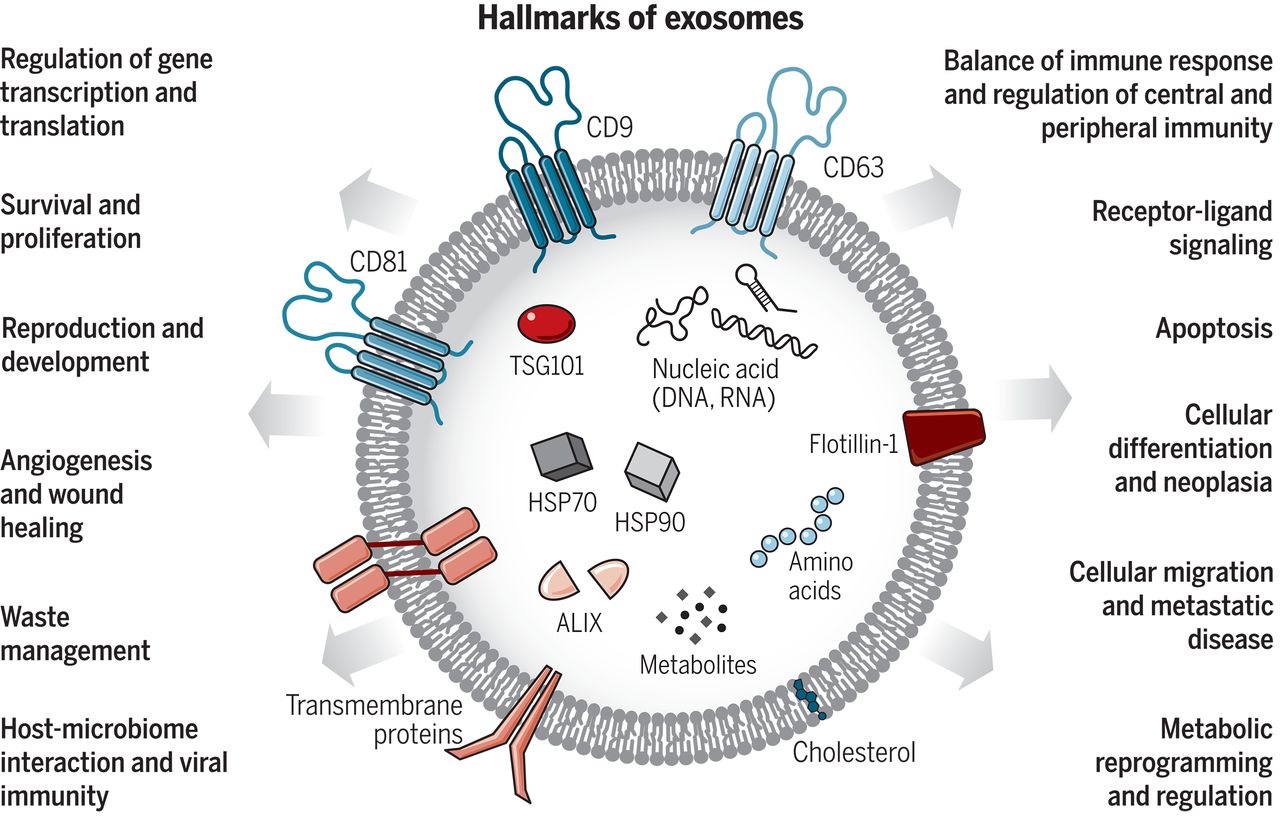Clinical uses of cellular communication
Exosomes are a type of extracellular vesicle that contain constituents (protein, DNA, and RNA) of the cells that secrete them. They are taken up by distant cells, where they can affect cell function and behavior. Intercellular communication through exosomes seems to be involved in the pathogenesis of various disorders, including cancer, neurodegeneration, and inflammatory diseases. In a Review, Kalluri and LeBleu discuss the biogenesis and function of exosomes in disease, highlighting areas where more research is needed. They also discuss the potential clinical applications of exosome profiling for diagnostics and exosome-mediated delivery of therapeutics to target disease cells.

All cells, prokaryotes and eukaryotes, release extracellular vesicles (EVs) as part of their normal physiology and during acquired abnormalities. EVs can be broadly divided into two categories, ectosomes and exosomes. Ectosomes are vesicles that pinch off the surface of the plasma membrane via outward budding, and include microvesicles, microparticles, and large vesicles in the size range of ~50 nm to 1 μm in diameter. Exosomes are EVs with a size range of ~40 to 160 nm (average ~100 nm) in diameter with an endosomal origin. Sequential invagination of the plasma membrane ultimately results in the formation of multivesicular bodies, which can intersect with other intracellular vesicles and organelles, contributing to diversity in the constituents of exosomes. Depending on the cell of origin, EVs, including exosomes, can contain many constituents of a cell, including DNA, RNA, lipids, metabolites, and cytosolic and cell-surface proteins. The physiological purpose of generating exosomes remains largely unknown and needs investigation. One speculated role is that exosomes likely remove excess and/or unnecessary constituents from cells to maintain cellular homeostasis. Recent studies reviewed here also indicate a functional, targeted, mechanism-driven accumulation of specific cellular components in exosomes, suggesting that they have a role in regulating intercellular communication.
ADVANCES
Exosomes are associated with immune responses, viral pathogenicity, pregnancy, cardiovascular diseases, central nervous system–related diseases, and cancer progression. Proteins, metabolites, and nucleic acids delivered by exosomes into recipient cells effectively alter their biological response. Such exosome-mediated responses can be disease promoting or restraining. The intrinsic properties of exosomes in regulating complex intracellular pathways has advanced their potential utility in the therapeutic control of many diseases, including neurodegenerative conditions and cancer. Exosomes can be engineered to deliver diverse therapeutic payloads, including short interfering RNAs, antisense oligonucleotides, chemotherapeutic agents, and immune modulators, with an ability to direct their delivery to a desired target. The lipid and protein composition of exosomes can affect their pharmacokinetic properties, and their natural constituents may play a role in enhanced bioavailability and in minimizing adverse reactions. In addition to their therapeutic potential, exosomes also have the potential to aid in disease diagnosis. They have been reported in all biological fluids, and the composition of the complex cargo of exosomes is readily accessible via sampling of biological fluids (liquid biopsies). Exosome-based liquid biopsy highlights their potential utility in diagnosis and determining the prognosis of patients with cancer and other diseases. Disease progression and response to therapy may also be ascertained by a multicomponent analysis of exosomes.
OUTLOOK
The study of exosomes is an active area of research. Ongoing technological and experimental advances are likely to yield valuable information regarding their heterogeneity and biological function(s), as well as enhance our ability to harness their therapeutic and diagnostic potential. As we develop more standardized purification and analytical procedures for the study of exosomes, this will likely reveal their functional heterogeneity. Nonetheless, functional readouts using EVs enriched for exosomes have already provided new insights into their contribution to various diseases. New genetic mouse models with the ability for de novo or induced generation of cell-specific exosomes in health and disease will likely show the causal role of exosomes in cell-to-cell communication locally and between organs. Whether exosome generation and content change with age needs investigation, and such information could offer new insights into tissue senescence, organ deterioration, and programmed or premature aging. Whether EVs and/or exosomes preceded the first emergence of the single-cell organism on the planet is tempting to speculate, and focused bioelectric and biochemical experiments in the future could reveal their cell-independent biological functions. Single-exosome identification and isolation and cryoelectron microscopy analyses have the potential to substantially improve our understanding of the basic biology of exosomes and their use in applied science and technology. Such knowledge will inform the therapeutic potential of exosomes for various diseases, including cancer and neurodegenerative diseases.
